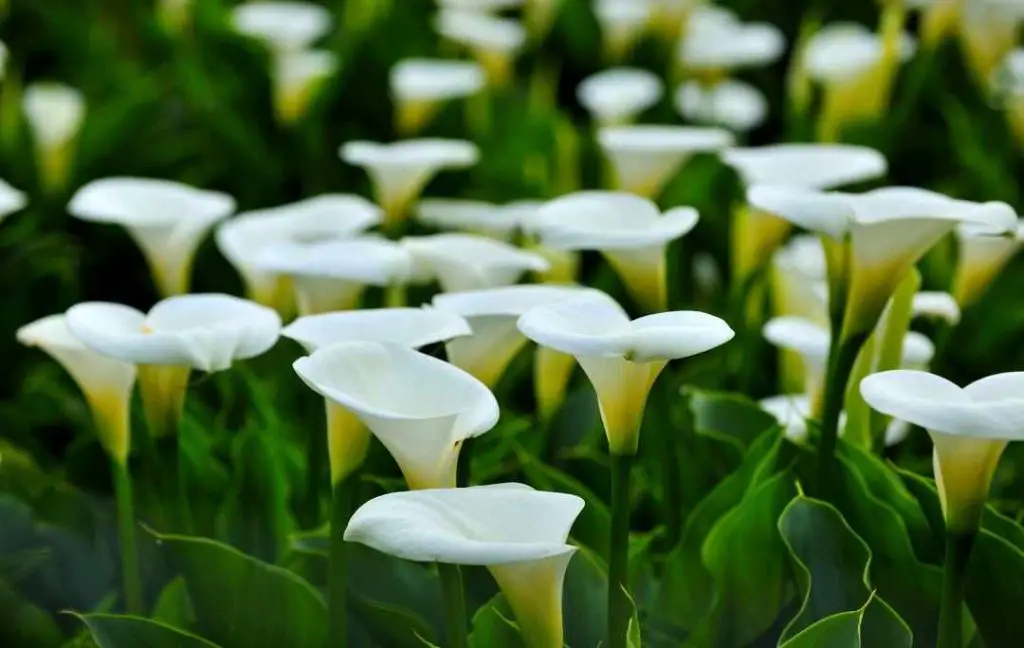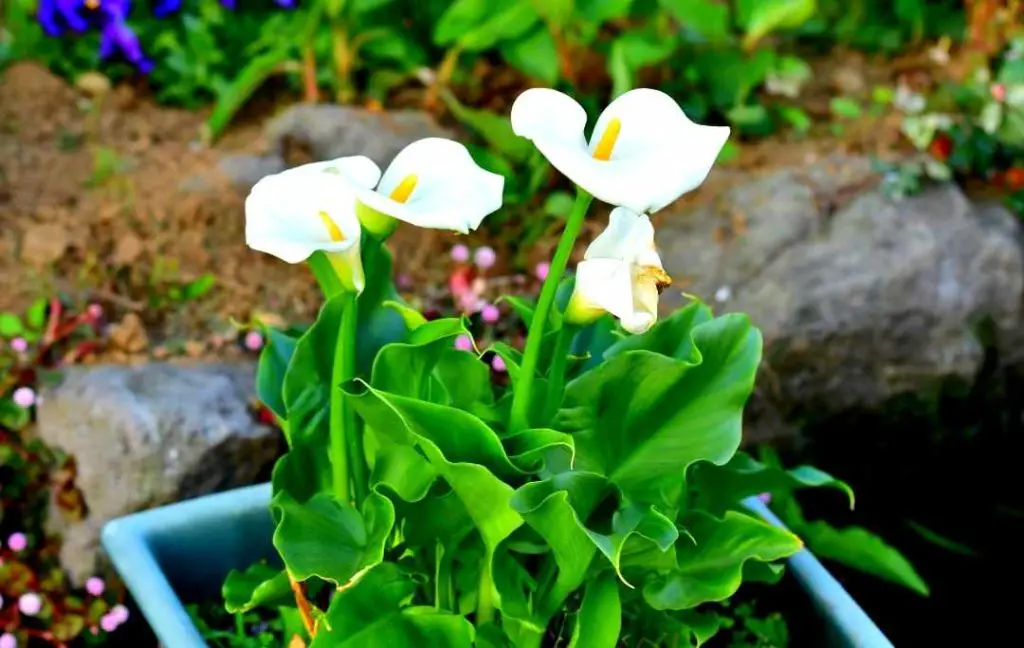You can grow calla lilies in your garden as well as an indoor plant. Cal is a perennial plant that produces trumpet-shaped flowers. Calla lilies produce beautiful and long-stemmed flowers. The flowers are found in different colors such as yellow, white, pink, and purple.
Where Can You Get Calla Lily Seeds?

If you don’t have any existing plant of calla lilies then there is an option of buying the seed pods from any local nursery or gardening store. Each seedpod contains one or two seeds.
In case you have a plant of calla lilies. Seedpod takes a few months for maturity so you should leave the pods attached to the plant and wait for maturity.
Calla lily seeds need 3 months of the dormancy period. If you are planning to prepare the seedlings indoors then you can plant them when they are ready. In case you are planting the seeds outdoors then you should wait for the spring season.
Steps On Pre-Growing Calla Lily Seeds
There is 2 easy propagation of calla lilies, the first one is by rhizomes and the second one is by seeds. In case propagating from rhizomes, each rhizome must have roots and eyes.
If you use calla lily seeds for planting purposes then it will take three years to bloom. It can be challenging but possible. It is suggested that you should follow the following tips and steps so you will be successful in growing calla lily blooms.
- First of all, you should take a bowl and fill it with warm tap water. Now submerge the seeds in the water and soak them for about 8 hours. This step helps to soften the outer seed coat and helps in the germination process of seeds.
- Spread all the seeds on a damp paper towel. After that, cover them.
- Now place this damp paper towel in a cool and dry place.
- A few days later, check the growth of the seeds. If you see any seed that is not showing signs of life then you can discard it.
- The seeds which are started can be planted in a pot. Make sure to fill the pot with a well-drained and high-quality acidic potting soil mix. It is suggested that you should plant only two seeds per pot.
- Moisture is very important for the growth of seeds so you should cover the pot with a plastic bag to retain the moisture. The suitable temperature for the seeds is about 70 to 75 degrees Fahrenheit. Bright and indirect light is recommended for the germination process.
- When the seeds sprout, you can move the pot to a sunny location where your young plants get 6 to 8 hours of direct sunlight. At this stage, you should remove the plastic bag.
- Keep the soil moist for the growth of your plants. If the soil dries before the germination of the seeds then the soil needs water.
- Keep an eye on the seeds for a couple of weeks when the seed sprouts then remove the weak shoots from each pot and keep the healthy one. In this way, the strong sprout will get proper nourishment from the soil.
Types Of Calla Lily

The most common calla lily flowers are white with the yellow spadix. Cultivars of Calla Lily have been developed in different colors.
1- ZANTEDESCHIA ‘EDGE OF NIGHT’
The color of the flowers of this plant is dark purple to dark black.
2- ZANTEDESCHIA ‘RED ALERT’
The color of the flowers of this plant is bright orange and red. You can see stunning blooms from May to August.
3- ZANTEDESCHIA ‘PICASSO’
The color of the flowers of this plant is white with a purple throat.
4- ZANTEDESCHIA ‘SUNSHINE’
This plant can produce beautiful and bright yellow flowers.
Caring For Your Growing Sprouts
There is a difference between the calla lily seedlings and the fully grown plants. So the caring tips will be different in each case. Water is an important factor for your plants. With the help of your fingers, you can check the moisture level of the soil.
The seedlings need sunlight for about 6 to 8 hours per day. You should be careful about the selection of the spot for your seedlings. If you are preparing seedlings indoors then a sunny window sill is a perfect place or you can use artificial lights.
Moisture and humidity are very important for your calla lily seedlings. You can use plastic bags for retaining humidity and moisture in the soil. As your seedling grows you can remove the plastic bag for further development and growth.
Your calla Lily plants don’t need regular pruning but if you see wilted leaves and flowers then you should remove them from your plants. In this way, your plants become more productive.
At the end of the growing season when the flowers die back you can cut them down to the soil level and if you see any debris then dispose of it.
Caring For Calla Lilies During Cooler Winters
When winter comes and flowers die then stop watering your calla lily plants.
- After stopping the watering and feeding then the plant will enter a state of dormancy. The leaves will start turning yellow. This phase comes once a year and usually in winter. This process will help the plant to recoup its energy for the next growing season.
- When the foliage dies back then you can cut down with the help of scissors or shears.
- Before the last Frost dig of the bulbs for this purpose, you have to loosen the soil with the help of a spread on your hands now remove the worms in the soil. If you are living in a warm climate then you can leave the bulbs in the ground. Now rinse the bulbs which you remove from the soil. After removing the excess dirt, let the bulbs dry with the help of the towel. There is extra growth around the bulbs then you can trim it with scissors. Now leave the bulbs overnight for drying before putting them in storage for winter.
- Now store all the bulbs in a cool and dry place until spring. A paper bag or a pot filled with Peat Moss is the best option for storing the bulbs until the time comes to replant them in the spring.
- The suitable temperature for storing the bulbs is about 60 to 75 degrees Fahrenheit or 15.5 to 24 degrees centigrade.
What To Do When It’s Time To Transplant?
Whether you want to transplant the seedlings in a new pot or outdoors, the seedling must have a second set of true leaves. This is a very important thing that the first pairs of leaves on calla Lily seedlings are not through leaves but seed leaves.
When the size of the seedlings is big enough you can transplant them into a 6 inches deep pot. Make sure the pot must have drainage holes and the size and the depth of the pot must be according to the size of the old pot. For filling the pot you must use a well-drained high-quality potting mix.
If you want to transplant the seedlings in your garden outdoors then early summer is the best time for doing so. For transplanting the seedlings in the ground you should use the same depth in the ground as the young seedlings are in the court.
The location is very important so you should choose that area of your garden where young calla lily seedlings receive at least 8 hours 6 to 8 hours of sunlight daily. When calla lilies seedlings are planted outside they need 1 to 2 inches of water per week.
Calla Lily plants can produce a lot of flowers and blooms for a long time so they need rich nutrients in the soil. For this purpose, you need to dilute fertilizer 10-10-10.
When plants start producing flowers then you can increase the amount of fertilizer to every 2 weeks. Avoid using a fertilizer that contains a high level of nitrogen because it will encourage foliage and discourage flowering.
If you follow the above tips and instructions then you will easily grow calla lilies from seeds without facing any trouble. Time and patience is the only condition for achieving your purpose.

Pests And Diseases
When you are growing calla lilies then mostly are affected by bacterial soft rot and botrytis a fungal disease. If you see a filmy grey mold over the petals, leaves, and stem of the plant it means your calla Lily plant is affected by botrytis.
To avoid this problem you have to reduce the quantity of water because overwatering is the main reason for this fungal disease. Make sure there is ample distance between calla lily plants so they get ample air circulation to breathe.
Some common pests and insects such as spider mites, aphids, and slugs can be an issue for calla lily plants. To fight this problem you can use insecticidal soap or neem oil.
If you see the edges of the leaves are turning brown then it means you are giving too much fertilizer to your plants. Excessive nitrogen can cause this problem, by reducing the amount of nitrogen-rich fertilizer you can control this problem.
Read More
